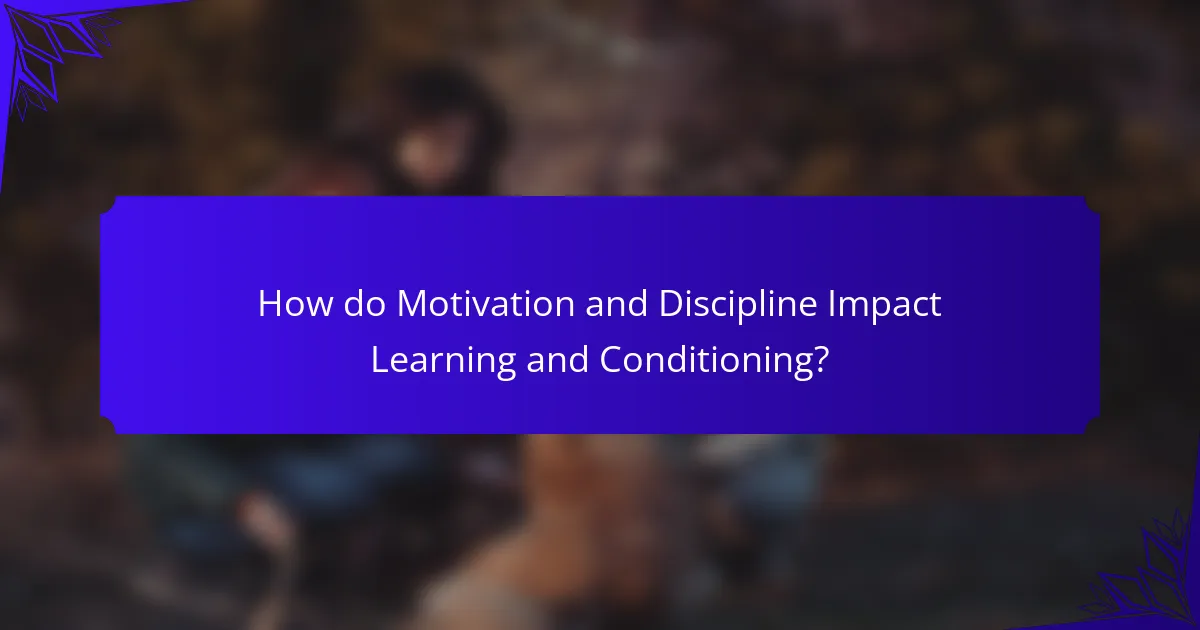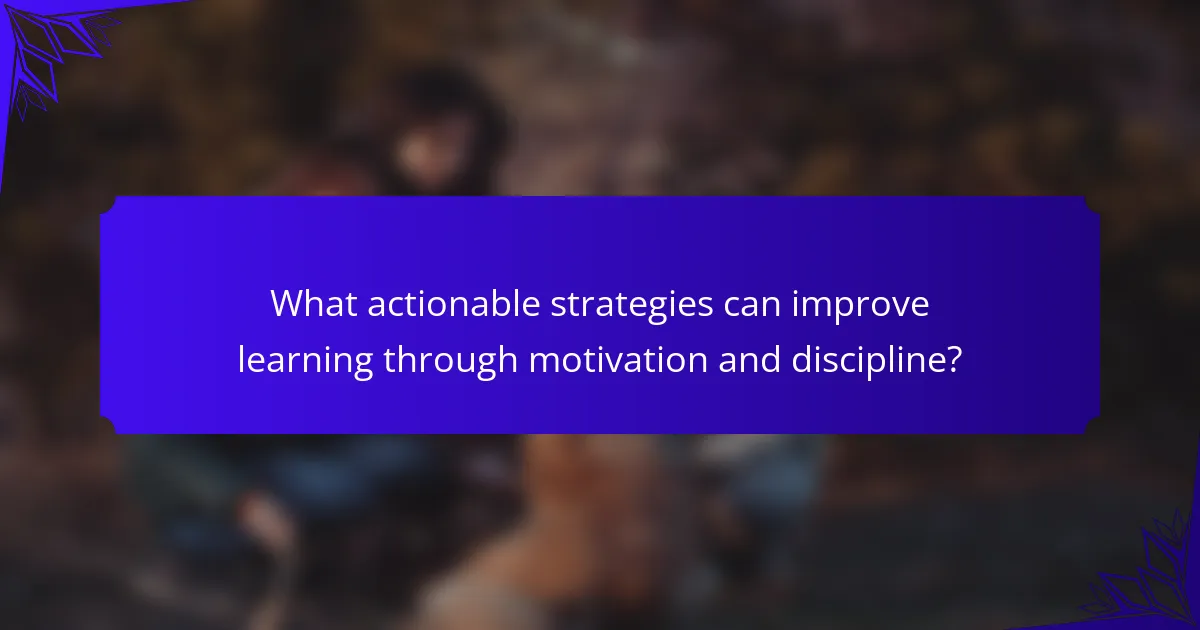Effective learning hinges on understanding motivation and discipline. Motivation drives the desire to learn, while discipline ensures consistent effort. This article explores how these two elements enhance personal growth, outlines unique strategies to foster them, and examines their rare attributes in modern contexts. By integrating structured goal-setting and positive reinforcement, individuals can significantly improve their learning outcomes.

How do Motivation and Discipline Impact Learning and Conditioning?
Motivation and discipline significantly enhance learning and conditioning by fostering persistence and focus. Motivation drives the desire to learn, while discipline ensures consistent effort. Together, they create a productive environment for skill acquisition and behavioural change. Research indicates that motivated learners engage more deeply, leading to better retention and application of knowledge. Discipline, on the other hand, cultivates habits that reinforce learning, making it easier to overcome challenges and setbacks. This synergy between motivation and discipline is crucial for effective learning strategies in modern life.
What are the key differences between motivation and discipline?
Motivation drives action through desire, while discipline ensures consistent effort regardless of feelings. Motivation is often transient, influenced by external factors, whereas discipline is a steadfast commitment to goals. Motivation can ignite initial action, but discipline sustains long-term progress. Understanding these differences enables effective learning and conditioning strategies in modern life.
Why is understanding the interplay between motivation and discipline crucial for effective learning?
Understanding the interplay between motivation and discipline is crucial for effective learning because both elements drive achievement. Motivation ignites interest and engagement, while discipline ensures consistency and perseverance. Together, they create a balanced approach to learning, enabling individuals to set goals and follow through. Research indicates that motivated learners are more likely to adopt disciplined study habits, leading to improved performance and retention. This synergy fosters resilience, allowing learners to navigate challenges and adapt strategies as needed.

What are the universal attributes of motivation and discipline?
Motivation and discipline share universal attributes that enhance personal growth. Both drive goal achievement, foster resilience, and promote consistency. Motivation ignites the desire to pursue objectives, while discipline ensures sustained effort towards those objectives. Together, they create a powerful synergy essential for effective learning and conditioning strategies in modern life.
How do intrinsic and extrinsic motivations affect learning outcomes?
Intrinsic motivation enhances learning outcomes by fostering engagement and curiosity. Extrinsic motivation can drive performance through rewards or recognition. Both types influence persistence and achievement, but intrinsic motivation often leads to deeper understanding and long-term retention. Balancing these motivations is key for effective learning strategies.
What role does consistency play in discipline?
Consistency is crucial in discipline as it fosters reliable habits and reinforces learning. When individuals practice consistently, they develop a strong foundation for retaining knowledge and skills. This reliability enhances motivation, as progress becomes visible over time. As a result, the synergy between consistency and discipline creates a structured approach to effective learning and conditioning, ultimately leading to long-term success.

What unique strategies enhance motivation and discipline in learning?
Unique strategies that enhance motivation and discipline in learning include setting specific goals, incorporating self-reflection, and utilising positive reinforcement. These techniques foster a growth mindset and create a structured environment conducive to learning. For example, breaking larger tasks into smaller, manageable goals can enhance motivation by providing clear milestones. Additionally, self-reflection allows learners to assess their progress and adjust strategies accordingly, reinforcing discipline. Positive reinforcement, such as rewards for achieving goals, strengthens the connection between effort and success, further motivating learners.
How can goal-setting techniques boost motivation?
Goal-setting techniques significantly enhance motivation by providing clear objectives and measurable progress. Setting specific, attainable goals creates a roadmap, fostering a sense of purpose. This alignment between goals and personal values boosts intrinsic motivation, leading to sustained effort. Research indicates that individuals who set goals are more likely to achieve higher performance levels. By breaking larger goals into smaller, manageable tasks, one can maintain momentum and celebrate incremental successes, reinforcing motivation throughout the process.
What specific discipline-building practices are most effective?
Effective discipline-building practices include setting clear goals, creating structured routines, and employing self-monitoring techniques. These strategies foster consistency and resilience in learning. For instance, establishing specific, measurable objectives enhances focus and motivation. Regularly scheduled study times create a habit, making learning a priority. Self-monitoring through journaling or progress tracking reinforces accountability and reflects on growth. Implementing these practices can significantly improve discipline and learning outcomes.

What are the rare attributes of motivation and discipline in modern contexts?
Motivation and discipline in modern contexts exhibit rare attributes such as intrinsic alignment and adaptive resilience. Intrinsic alignment refers to the harmony between personal values and goals, enhancing commitment. Adaptive resilience involves the ability to adjust strategies in response to challenges, fostering sustained effort. These attributes are crucial for effective learning and conditioning, as they enable individuals to navigate complex environments and maintain focus despite setbacks.
How do cultural factors influence motivation and discipline in learning?
Cultural factors significantly shape motivation and discipline in learning by influencing values and expectations. For example, collectivist cultures prioritise group success, enhancing motivation through community support. In contrast, individualistic cultures often emphasise personal achievement, fostering self-discipline. Additionally, cultural norms dictate acceptable learning methods and attitudes toward failure, impacting persistence. Understanding these variations can optimise learning strategies tailored to cultural contexts.
What uncommon techniques can be applied to cultivate discipline?
Uncommon techniques to cultivate discipline include setting micro-goals, employing time-blocking, and using accountability partners. Micro-goals break tasks into manageable steps, making progress feel achievable. Time-blocking allocates specific time slots for tasks, enhancing focus. Accountability partners provide external motivation, reinforcing commitment to goals.
How does technology impact motivation and discipline?
Technology enhances motivation and discipline by providing tools that facilitate goal tracking and personalised learning experiences. Digital platforms offer instant feedback, fostering a sense of achievement that boosts motivation. Gamification elements, such as rewards and challenges, create engaging environments that promote discipline in learning and habit formation. Additionally, technology enables access to diverse resources, allowing individuals to tailor their learning paths, which can lead to improved outcomes. The integration of these tools can significantly impact effective learning strategies in modern life.

What actionable strategies can improve learning through motivation and discipline?
To improve learning through motivation and discipline, integrate structured goal-setting, consistent routines, and positive reinforcement. Establish clear, achievable objectives to enhance focus and drive. Create a daily schedule to build discipline, ensuring dedicated time for study and practice. Use rewards to reinforce progress, fostering a positive learning environment.
What are the best practices for integrating motivation and discipline into daily routines?
Integrating motivation and discipline into daily routines involves creating structured habits that reinforce each other. Start by setting clear, achievable goals to maintain motivation. Establish a consistent schedule to cultivate discipline. Use positive reinforcement to reward progress, which enhances motivation. Incorporate reflection sessions to assess achievements and adjust strategies, ensuring continuous improvement. Prioritise tasks to align daily actions with long-term objectives, fostering a disciplined approach.
What common mistakes should be avoided in fostering motivation and discipline?
To foster motivation and discipline effectively, avoid common mistakes like setting unrealistic goals, neglecting progress tracking, and failing to create a supportive environment. These errors can undermine motivation and hinder discipline. Setting achievable goals ensures sustainable progress. Regularly tracking progress helps maintain accountability. A supportive environment fosters positive reinforcement and reduces distractions, enhancing overall effectiveness in learning and conditioning strategies.
How can feedback mechanisms enhance learning outcomes?
Feedback mechanisms significantly enhance learning outcomes by fostering engagement and adaptability. They provide timely insights that help learners adjust their strategies, improving retention and understanding. For instance, regular feedback encourages motivation, making learners more invested in their progress. As a result, they can identify strengths and weaknesses, leading to personalised learning paths. Moreover, effective feedback cultivates discipline, reinforcing positive behaviours and promoting consistent effort in learning activities. This dual approach ultimately unlocks effective learning and conditioning strategies in modern life.


